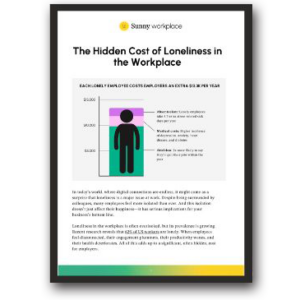
The real reason mental health solutions aren’t improving employee well-being
Despite recent strides in workplace mental health benefits and programs, overall employee wellness continues to stagnate—or even decline. Why?
While more and more people are recognizing the profound impact of mental health on employee well-being and overall productivity, the sweeping initiatives and investments made in recent years aren’t delivering the expected improvements.
This article explores the puzzling disconnect between services offered and results achieved. It also provides actionable steps and fresh ideas for employers to truly enhance employee mental health and well-being.
The current landscape of workplace mental health
Workplace mental health has become a critical issue, with numerous studies highlighting the significant toll mental health challenges can take on both employees and organizations. According to the World Health Organization (WHO), depression and anxiety alone cost the global economy an estimated $1 trillion annually in lost productivity. In the United States, mental health-related issues rank among the leading causes of disability, with stress and burnout affecting millions of workers each year.
Despite increased awareness, many mental health initiatives in the workplace seem to fall short of their intended goals. A recent study in the UK by the University of Oxford revealed that most workplace mental well-being interventions showed no significant improvement in participants’ well-being compared to those who did not participate.
So, why aren’t current mental health solutions improving employee well-being? And what can be done to bridge this gap?
The connection between mental health and employee well-being
To understand why current mental health solutions aren’t yielding the desired outcomes, it’s essential to look at the link between mental health and overall employee well-being. Well-being encompasses not just mental health, but also the physical, social, and emotional aspects of life. When mental health initiatives focus too narrowly on individual-level interventions—such as mindfulness apps or therapy sessions—they may miss the broader context in which employees live and work.
Research shows that well-being is deeply connected to social relationships and community support. A study by the American Psychological Association (APA) found that individuals who feel connected to their community are more resilient to stress and experience lower levels of depression and anxiety. In contrast, isolation and loneliness—often exacerbated by remote work or rigid workplace cultures—can significantly undermine mental health efforts, no matter how well-intentioned.
The importance of comprehensive mental health solutions in the workplace
While individual-focused mental health solutions are vital, they must be part of a broader approach that also addresses the social and community aspects of well-being. This is where many current workplace mental health programs fall short. They often emphasize personal responsibility for mental health, offering resources like Employee Assistance Programs (EAPs) or stress management workshops, while overlooking the role of the work environment and organizational culture in shaping mental health outcomes.
Critics of articles like those published in Forbes and Fortune, which argue that workplace wellness programs are ineffective, suggest that the failure lies not in the concept of mental health support but in its implementation. For example, when workplace wellness programs are treated as a checkbox rather than a core part of the organizational culture, they are unlikely to make a meaningful impact. Moreover, programs that don’t foster a sense of community or address systemic issues—such as excessive workloads, lack of autonomy, or poor management practices—may do little to improve mental health and well-being in the long run.
5 ways employers can support employee well-being through mental health
To create a genuinely supportive environment that enhances employee well-being, employers must go beyond surface-level interventions. Here are five strategies that can make a real difference:
1. Cultivate a culture of connection
Encourage social interactions and peer support within the workplace. Whether through team-building activities, regular check-ins, or informal gatherings, fostering a sense of community can help employees feel more connected and supported. This, in turn, can reduce feelings of isolation and enhance mental well-being.
2. Address workload and stress
One of the most significant contributors to poor mental health in the workplace is excessive stress. Employers should regularly assess workloads and ensure that employees have the resources and autonomy needed to manage their tasks effectively. Implementing flexible work arrangements and promoting work-life balance are also critical in reducing stress and preventing burnout.
3. Create inclusive and supportive environments
Employees are more likely to thrive in workplaces where they feel valued and respected. Employers should strive to create an inclusive environment where diversity is celebrated, and all employees feel safe to express themselves. Providing training on mental health awareness and inclusive practices can help build a more supportive workplace culture.
4. Integrate mental health into the organizational framework
Rather than treating mental health as an add-on, integrate it into the core of the organization’s policies and practices. This can include offering mental health days, providing comprehensive health insurance that covers mental health services, and including mental health metrics in organizational performance reviews.
5. Leverage community resources
Employers can also tap into external resources to support their employees’ mental health. Partnering with local mental health organizations, offering access to community support groups, or providing resources for family support can help employees find the help they need outside of work. This community-based approach can enhance the effectiveness of workplace mental health initiatives by addressing the broader context of employees’ lives.
Resources for employers on investing in employee mental health
Investing in employee mental health isn’t just a moral obligation; it’s also a smart business strategy. Companies that prioritize mental health and well-being often see higher levels of engagement, productivity, and retention. To help employers make informed decisions, numerous resources are available:
• National Alliance on Mental Illness (NAMI): Offers a range of resources for employers, including guides on creating mental health-friendly workplaces and supporting employees with mental health conditions.
• American Psychological Association (APA): Provides research-based resources on workplace well-being, including tools for stress management and resilience-building.
• Mental Health America (MHA): Offers a variety of workplace mental health resources, including toolkits and webinars designed to help employers support their employees’ mental health effectively.
The path forward: a holistic approach to employee well-being
Most corporate mental health solutions are simply too narrow in focus. They’re not working because they fail to address the full context of employee social well-being.
To make a more meaningful impact, employers should adopt a holistic approach that considers the broad implications of employees’ lives, including their social connections, work environment, and access to community resources. By fostering a culture of connection, addressing systemic stressors, and integrating mental health into the organizational framework, companies can create a supportive environment where employees truly thrive.
Quick fixes and one-size-fits-all solutions fall short. But a genuine commitment to understanding and addressing the complex factors that influence mental health—both inside and outside the workplace—cultivates long-term improvements in employee well-being.


